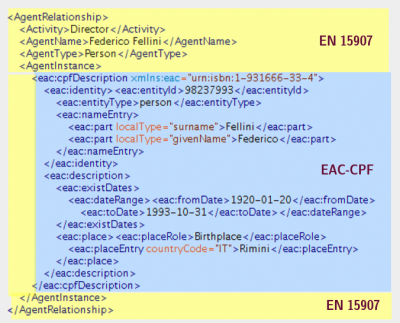Difference between revisions of "Agent and event: Further examples"
From filmstandards.org
(Created page with "''From the TC 372 Workshop Compendium'' ==The Agent entity== The Agent entity was deliberately left '''underspecified''' in EN 15907. This decision was made in order to fac...") |
|||
| Line 18: | Line 18: | ||
Data from such systems can be translated straightforwardly into an EN 15907 data structure by using the Agent Name and Activity elements of an '''Agent Relationship''' | Data from such systems can be translated straightforwardly into an EN 15907 data structure by using the Agent Name and Activity elements of an '''Agent Relationship''' | ||
|} | |} | ||
| + | |||
| + | {| style="float: right; border: 1px solid #BBB; margin: .46em 0 0 .2em;" | ||
| + | |- | ||
| + | | valign="top" width="405px" |[[File:Agent-include-1.png|400px]]<br /> | ||
| + | <span style="font-size:8pt"> | ||
| + | </span> | ||
| + | |||
| + | | valign="top" width="405px" | | ||
| + | The second method of handling an Agent Reference is to '''include descriptive data''' about the agent, encoded in a suitable format. | ||
| + | |||
| + | Evidently, this requires a '''relational data model''' in which data about agents (e.g. persons) is separated from film-related information, and joined via a many-to-many relationship. | ||
| + | |||
| + | Using this method, Agent descriptions can be '''transferred alongside''' with filmographic data. The drawback of this solution is that the person record may have to be transferred multiple times. | ||
| + | |} | ||
| + | |||
| + | {| style="float: right; border: 1px solid #BBB; margin: .46em 0 0 .2em;" | ||
| + | |- | ||
| + | | valign="top" width="405px" |[[File:Agent-ref-3.png|400px]]<br /> | ||
| + | <span style="font-size:8pt"> | ||
| + | From: http://viaf.org/ | ||
| + | </span> | ||
| + | |||
| + | | valign="top" width="405px" | | ||
| + | The third method of handling an Agent Reference is to '''include a reference''' to a network resource with information describing the agent. | ||
| + | |||
| + | In this example, the reference points to a VIAF (virtual authority file) record obtained from the Istituto Centrale per il Catalogo Unico (ICCU). | ||
| + | |||
| + | EN 15907 permits '''any combination of agent references'''. Thus, if a database has references to external authority files for the more famous people and only names for the less famous, then both types can be used in a single data exchange. | ||
| + | |} | ||
| + | |||
| + | {| height="20px" width="100%" | ||
| + | |- style="text-align:center; " | ||
| + | |<span style="color:#808080"> • • • </span> | ||
| + | |- | ||
| + | |} | ||
| + | |||
| + | ==The Event entity== | ||
| + | |||
| + | The Event entity in EN 15907 is in fact a class of six event types that can occur in the lifecycle of a cinematographic work. | ||
Revision as of 07:59, 5 April 2011
From the TC 372 Workshop Compendium
The Agent entity
The Agent entity was deliberately left underspecified in EN 15907. This decision was made in order to facilitate interoperability among filmographic information systems with different data models.
 From: http://viaf.org/ |
The third method of handling an Agent Reference is to include a reference to a network resource with information describing the agent. In this example, the reference points to a VIAF (virtual authority file) record obtained from the Istituto Centrale per il Catalogo Unico (ICCU). EN 15907 permits any combination of agent references. Thus, if a database has references to external authority files for the more famous people and only names for the less famous, then both types can be used in a single data exchange. |
| • • • |
The Event entity
The Event entity in EN 15907 is in fact a class of six event types that can occur in the lifecycle of a cinematographic work.

